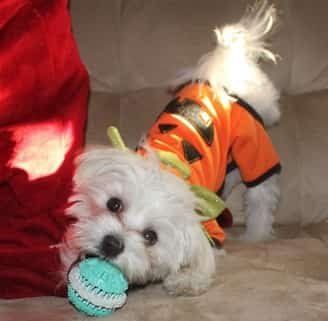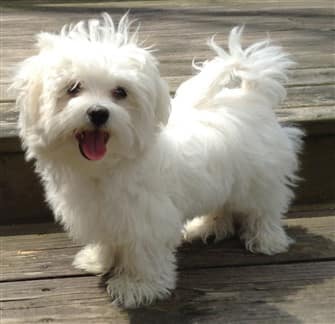Maltese Teething and Chewing Issues
Overview
Teething can be a difficult time for young pups, and just as frustrating for owners who are trying to control their pup's strong chewing urges.
In addition, chewing can be a problem for adult dogs as well. For some, bad habits were established at a young age, and these can be hard to break. And for others, such things as boredom or even stress can trigger an urge to chew.
Fortunately, there are several things that you can do to redirect teething and chewing urges in a healthy direction.
Please note: PetMaltese is reader-supported. Some of the product suggestions on this page are affiliate links. As an Amazon Associate we earn from qualifying purchases. This is at no extra cost to you and helps us continue creating useful content.
Teething Overview
The teething phase is a relatively quick phase, but a very intense one.
Milk teeth (also known as deciduous teeth or puppy teeth) can start poking out from the gums as early as 3 weeks. By the time a Maltese puppy is at the 6 to 8 week mark, most of his milk teeth have emerged.
Maltese puppies begin teething at the age of 3.5 to 4.5 months old. This is when the 28 milk teeth fall out and make way for 42 permanent adult teeth.
The entire teething process from puppy to adult teeth takes several months. During this time, the biggest issue will be intense chewing urges.
Common Tooth Issues During the Teething Phase
Milk teeth not falling out:
The most common issues seen during the teething stage have to do with the eruption of adult teeth before the puppy teeth fall out. This causes a double row of teeth. This can happen with just one tooth or several.
It will be important to assess your pup's teeth twice a week in order to keep an eye out for this.
If an adult tooth is allowed to fully come in while the milk tooth is still in place, this can cause major issues with alignment. For this reason, the veterinarian will need to extract the puppy tooth. This is normally a very minor procedure since milk teeth are very tiny and have very shallow roots.
Once that puppy tooth is out of the way, there is a good chance that the adult tooth will gradually move into place.
Milk teeth missing:
Another common event is wondering where in the world the milk teeth have gone. You didn't see them fall out, so where are they? In many cases, a tooth will come loose and the pup will swallow it. Since it is very small, this will almost never cause a problem. And there is always a chance that it came loose when outside, or even is at the bottom of your pup's toy collection.
Chewing Overview
In addition to teething issues, Maltese of just about any age (other than seniors), can display chewing problems. They may nibble at carpeting, gnaw at table legs, prefer to chew on your socks, pocketbook, or other personal items instead of toys... and basically seem to be out of control.
Fortunately, there is help for this as well. The tips and advice that you'll see ahead will work for just about any chewing issues.
How to Help a Teething Maltese Puppy or a Chew-Happy Adult
When a puppy is teething, he will have very itchy gums and also have some level of discomfort. There will be a strong natural urge to chew, as this both scratches the itch and helps make his gums feel better.
Without direction, a puppy will mouth, nibble, and even nip at just about anything. He does not know the rules, and is only seeking help for his woes.
With adults, chewing satisfies a need. Most canine behavior is not arbitrary. It is instinct. Adult dogs may simply like working their jaws. Or, they may be bored or feeling a bit stressed. So, you will not want to stop your Maltese from chewing, but rather redirect it in a healthy way.
Here are some tips to help:
1) Proof the house.
We hesitate to call this 'puppy proofing', since it should be done on a regular basis no matter your Maltese's age. There are an infinite number of household items that present dangers if mouthed. And just as many that you will be sorry that you did not put away if they get gnawed on.
Wrap electrical and cable cords with cord concealer. Place shoes and other items up high and out of reach. Go over the floors to pick up any small objects. Ideally, the only things that you will want your Maltese to have access to are the furniture (which needs to be there) and his own supplies and belongings.
A common issue is chewing on furniture legs, however this is resolved via the next 3 points below.
2) Supervision.
If your Maltese is tearing around the house and ripping things up, this is because he is not being watched.
Typically, until a pup is house trained and is done with the teething phase, a method should be used to keep him in one spot any time that you cannot have him right by your side.
Typically, until a pup is house trained and is done with the teething phase, a method should be used to keep him in one spot any time that you cannot have him right by your side.
And for adult Maltese that are having a hard time with understanding the rules, they should also be in their own area, where they cannot cause any destruction.
One of the best methods for this is to have an indoor canine playpen. These are also fantastic for helping a Maltese cope with separation anxiety.
Pens like the IRIS 24'' Playpen with a Door
 are pretty fantastic because they are good sized (unlike crates which are terribly confining), offer the feeling of a 'den', which most dogs perceive as a place of security, and keep all of a dog's items in one spot.
are pretty fantastic because they are good sized (unlike crates which are terribly confining), offer the feeling of a 'den', which most dogs perceive as a place of security, and keep all of a dog's items in one spot.
You may instead opt to use gates to block off an area. This may work; however you'll need to continually proof that room.
And if your Maltese is not fully housebroken, a gated area often means more piddles and poos spread out over a larger space.
3) Be sure that you have the right teething or chew toys.
There are 3 elements to this:
1. Size. The Maltese is a very tiny breed, and young pups that are teething or like to chew will need appropriately sized toys.
Many chew toys are made for medium and large sized dogs (as there are many more of them than toy breeds), so do be sure to obtain those made for toy breeds or are labeled as 'mini'. If a Maltese pup cannot work the toy into his mouth, it will be of little use.
2. Texture. For pups, you will also want the teething toys to be the right texture.
One type that works well are those with tiny nubs. These are really great for massaging the gums and offering a pleasing chewing experience.
The other are rope toys. These work well due to the twisted fabric working as a 'scratcher'.
For adult chewing, the texture will need to stand up to sharp adult teeth and have a pleasing pliability.
3. Appeal.
Puppies
have very short attention spans, so if a teething toy does not immediately pull a pup in and keep him interested, it will not work well.
One way to draw a pup in is with flavor and scent.
For all ages, toys that make noise are often great to both create an interest and hold it for a while.
This can be noises such as squeakers and crinkles. Or it can be toys that speak or make silly sounds.
4) Interrupt and Re-direct.
Just like dealing with excessive barking, an effective method to stop a Maltese from chewing on something is to interrupt the unwanted behavior and then re-direct your Maltese's focus to an approved behavior.
Here is what to do:
#1. Interrupt your Maltese.
Normally, we do not advise a sharp 'No!' for a teething puppy, since the urge to chew is not a 'bad' behavior. A 'no' may be appropriate in some cases for adults; it really depends what they are chewing on.
If the dog is ripping at the carpeting, a 'no' would be applicable; after all, you had no way to proof for that. However, if your Maltese is biting at your shoe, that shoe should not have been there. Most dogs have no idea what is a toy and what is not, unless they are taught.
Since a sharp word is not always the right thing to do, you may clap your hands together loudly. This works for some dogs. Each has their own sensitivity to this. For those that ignore their humans, a behavior interrupter device (those that make a short hissing noise) may work better. One that is very effective is the The Company of Animals Pet Corrector .
.
#1 Re-direct. Once you have your Maltese's attention, it will be important to immediately show him what you'd like for him to be doing instead, which will be chewing on a toy. So, do be ready for this.
You will not want any pauses such as jogging away to find his toy. You may wish to have small bins in several places, so that they are right within reach.
Offer your dog a tempting toy, using enthusiasm. If it is a teething toy that holds a scent and flavor like those in the Nylabone Puppy Chew Toy Starter Set , wave it under his nose. If it is a chew toy that makes a noise, show him that noise a few times.
, wave it under his nose. If it is a chew toy that makes a noise, show him that noise a few times.
As soon as your Maltese takes the toy, give praise via a happy 'Good, dog!'.
If several minutes go by and your Maltese is still paying attention to his toy, offer more praise and occasionally a treat; but do not interact with him to such an extent that you draw his focus away from his good behavior.
When this sort of training is repeated for every infraction, within two weeks or so, a dog will understand what is expected.

-min-450x169-1920w.jpg)
-min-329x335-1920w.jpg)




-min-180x187-1920w.jpg)